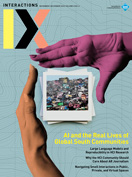Authors:
Victoria McArthur
On June 23, 2018, 25-year-old assistant soccer coach Ekkapol Chantawong led 12 team members, ages 11 to 16, on an exploration of the Tham Luang Cave in Thailand. Soon after the team entered the cave, heavy rainfall flooded a significant portion of the 6.2-mile system, trapping them inside. Nine days later, on July 2, the group was found deep within the cave on an elevated rock, a couple of miles from the cave's main entrance. Rescue efforts were impeded by rising waters, limited visibility, strong currents, and a complex tunnel system in the cave with extremely narrow passages. To…
You must be a member of SIGCHI, a subscriber to ACM's Digital Library, or an interactions subscriber to read the full text of this article.
GET ACCESS
Join ACM SIGCHIIn addition to all of the professional benefits of being a SIGCHI member, members get full access to interactions online content and receive the print version of the magazine bimonthly.
Subscribe to the ACM Digital Library
Get access to all interactions content online and the entire archive of ACM publications dating back to 1954. (Please check with your institution to see if it already has a subscription.)
Subscribe to interactions
Get full access to interactions online content and receive the print version of the magazine bimonthly.






